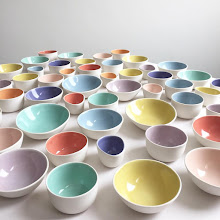In 2012 I was contacted by a client who had a large wall with plate railings already installed, that he wanted to see filled with my plates. How amazing is that! Dream job! (or so I thought)
The usual glaze I had developed for my work has a slightly glossier surface than what the client was looking for, he preferred a more matte surface. I felt uneasy about applying a matte glaze to my plates, but ignored the feeling because I was super excited by the project: 200 plates, in four different sizes, all installed on one large wall. Beautiful. Or it would have been: if I had stood up for the glazes I already work with. My glazes are all original recipes that I have developed over the past decade. They work perfectly with my porcelain, which I also mix myself. Feeling invincible, I proceeded to explore totally new glaze colors and surfaces. Without insisting on an R&D, Research and Development, budget!
I spent four months testing glaze recipes from many sources. I tested seven different recipes and 45 different color mixes until I found one recipe that beautifully carried the light colors requested by the client. The surface was a semi-matte. The glaze worked wonderfully on SMALL test plates (5" in diameter) that I used as test tiles. I proceeded to mix two-gallon batches and apply the glaze to the larger plates: 10", 11.5", and 13.5" in diameter. Can you guess what happened?
The glaze broke every single large plate in the firing:
I was stunned. I immediately contacted my professor from RISD for help, Larry Bush was a master glazer. (Update: sadly, Larry passed away at the age of 65 a few years later. I miss his mentorship and wisdom) Larry told me that I was crazy (yes, crazy lol) trying to apply a matte surface to one side of a large plate. The shrinkage rate of glaze vs. porcelain puts too much pressure on the piece and cracks it. I never had a problem with the glaze that I usually work with. Again, I should have STOOD UP for my usual glaze. Larry suggested that I glaze both sides of the plates with the matte glaze, and as I don't have a foot on them, here is the process I tried:
1. I applied circular stickers to the bottom of a bisque plate, glazed it, removed the circular stickers.
2. I glued kilnwash feet (a clay mixture that does not stick to the porcelain or the kiln shelf) into each of the circles with Elmer’s Glue. The plates are porcelain, and would sag if I did not have enough support. That's why there are so many feet. Crazy, I know. I was desperate.
This labor-intense glazing process worked, the plates did not crack. They did warp a little, because they were suspended in the kiln on stilts, with the heat and air hitting them throughout the 24-hour firing. Porcelain turns to liquid when it reaches the high temperature I fire to, and is susceptible to subtle movements in the firing. I thought the movement of the plates was lovely, the client didn’t. Again, I should have stood up for my usual glaze, I didn’t.
I kept testing, and finally after many more cracked plates, by accident, got a new glaze to work. This new glaze turned out glossy on a first glaze firing, but then turned satiny-matte on the second, lower temperature fire. I was ecstatic, and as I sat down to write of this success to the client, I got an email from them saying that they are canceling the project. I was too exhausted by this point to argue. But here are the beautiful plates that I came up with for an installation that got cancelled after nine months of really hard research and development:
Did I get a deposit? Yes, I did. Did the deposit cover my expenses for this nine-month-long exploration? Not even close. Here are three very important lessons that I learned from this experience:
1. I should have stood up for the glaze I have been working with for the past ten years. It works and it’s beautiful.
2. If agreeing to test new glazes, I have to request a research and development budget. There must be an understanding that after the research and development stage is finished, there might not be a workable result.
3. For a project this size I must have a contract, spelling out detailed steps of the process, risks involved, and what happens when either the client or I back out.
There was no happy ending to this project, it put me under financially and emotionally, but I did learn a great deal. And, if anyone knows of a wall in need of a sculptural plate installation, give me a ring.
skip to main |
skip to sidebar
archives
-
►
2024
(1)
- March 2024 (1)
-
►
2023
(1)
- August 2023 (1)
-
►
2022
(4)
- November 2022 (3)
- August 2022 (1)
-
►
2020
(5)
- September 2020 (1)
- August 2020 (1)
- April 2020 (1)
- March 2020 (1)
- January 2020 (1)
-
►
2019
(3)
- August 2019 (2)
- February 2019 (1)
-
►
2018
(5)
- September 2018 (1)
- August 2018 (1)
- June 2018 (1)
- February 2018 (1)
- January 2018 (1)
-
►
2017
(9)
- December 2017 (1)
- November 2017 (2)
- September 2017 (1)
- August 2017 (1)
- May 2017 (1)
- April 2017 (1)
- February 2017 (1)
- January 2017 (1)
-
►
2016
(18)
- December 2016 (2)
- November 2016 (1)
- October 2016 (2)
- September 2016 (1)
- July 2016 (1)
- May 2016 (2)
- March 2016 (3)
- February 2016 (3)
- January 2016 (3)
-
►
2015
(26)
- December 2015 (2)
- November 2015 (2)
- September 2015 (2)
- August 2015 (3)
- July 2015 (4)
- May 2015 (1)
- April 2015 (2)
- March 2015 (3)
- February 2015 (5)
- January 2015 (2)
-
►
2014
(35)
- November 2014 (1)
- October 2014 (3)
- September 2014 (1)
- July 2014 (2)
- June 2014 (1)
- May 2014 (3)
- April 2014 (6)
- March 2014 (5)
- February 2014 (7)
- January 2014 (6)
-
►
2013
(69)
- December 2013 (7)
- November 2013 (5)
- October 2013 (2)
- August 2013 (2)
- July 2013 (4)
- June 2013 (3)
- May 2013 (10)
- April 2013 (8)
- March 2013 (10)
- February 2013 (10)
- January 2013 (8)
-
▼
2012
(62)
- December 2012 (3)
- November 2012 (4)
- October 2012 (3)
- September 2012 (4)
- August 2012 (1)
- July 2012 (7)
- June 2012 (6)
- May 2012 (2)
- April 2012 (10)
- March 2012 (8)
- February 2012 (10)
- January 2012 (4)
-
►
2011
(71)
- December 2011 (3)
- November 2011 (4)
- October 2011 (7)
- September 2011 (5)
- August 2011 (7)
- July 2011 (3)
- June 2011 (4)
- May 2011 (3)
- April 2011 (9)
- March 2011 (7)
- February 2011 (10)
- January 2011 (9)
-
►
2010
(116)
- December 2010 (4)
- November 2010 (7)
- October 2010 (5)
- September 2010 (8)
- August 2010 (10)
- July 2010 (9)
- June 2010 (16)
- May 2010 (11)
- April 2010 (20)
- March 2010 (8)
- February 2010 (7)
- January 2010 (11)
-
►
2009
(248)
- December 2009 (18)
- November 2009 (16)
- October 2009 (25)
- September 2009 (24)
- August 2009 (29)
- July 2009 (19)
- June 2009 (25)
- May 2009 (28)
- April 2009 (31)
- March 2009 (23)
- February 2009 (1)
- January 2009 (9)
-
►
2008
(51)
- December 2008 (11)
- November 2008 (12)
- October 2008 (10)
- September 2008 (18)
topics
gleena press
- 100 Layer Cake
- alison tauber
- anthology
- anything indie
- apartment therapy
- bearleader chronicle
- best of RI 2008
- better homes & gardens
- blomma finds
- bon appétit
- bonbon oiseau design
- cannelle et vanille
- cooking light
- daily candy
- decor8
- decorology
- design mom
- design*sponge
- etsy wedding
- fine little love
- food & wine
- gourmet worrier
- house beautiful
- housemartin
- inStyle
- lushlee
- martha stewart living
- oh joy!
- oh so beautiful paper
- puddingstone post
- risd ceramics blog
- risd ceramics blog
- slang from chaos
- soule mama
- southern flourish
- style me pretty
- sunday suppers
- tartelette
- the daily meal
- the providence journal
- the storque
- the wall street journal
- thimble+twine
- try handmade
- uppercase
- urban sherp
- veshiwish
- weddingbee
ceramic inspiration
- brickett davda
- christiane perrochon
- cliff lee
- daniel reynolds
- deirdre hawthorne
- diana fayt
- edmund de waal
- elephant ceramics
- galerie besson
- gleena
- heath
- heather knight
- helen felcey
- hyejeong kim
- jan burtz
- karen swyler
- kirstie van noort
- louise boscacci
- mae mougin
- marie hermann
- matin gallery
- middle kingdom porcelain
- mud
- nathalie derouet
- pamela sunday
- royal tichelaar makkum
- rupert spira
- samantha robinson
- stepanka
- taizo
- tania rollond
- the clay studio
- tsé & tsé
- whitney smith












